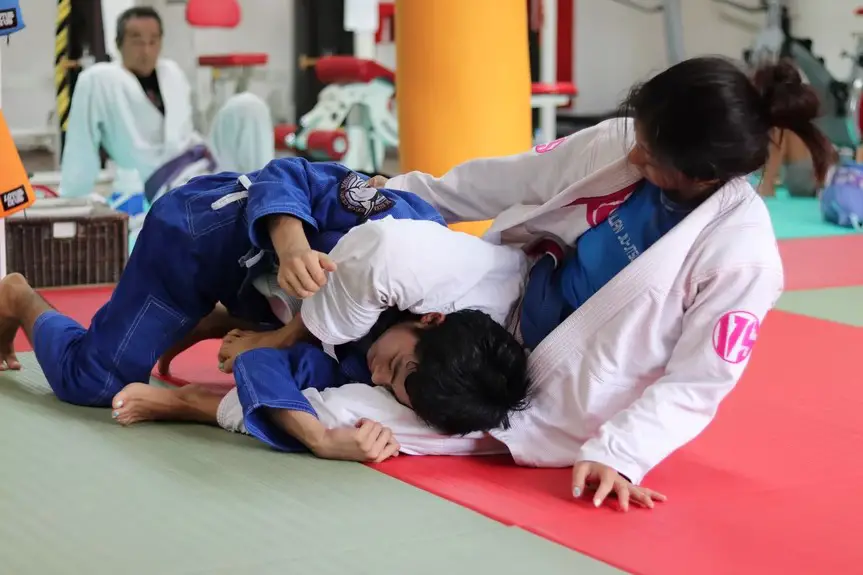Jiu-jitsu, a martial art, encompasses multiple forms, each with unique philosophies, techniques, and goals. Two main forms—Japanese Jiu-jitsu (JJJ) and Brazilian Jiu-jitsu (BJJ)—share historical roots but diverge in approach, training, and practical application.
Understanding these differences can help practitioners and enthusiasts choose the form that best suits their needs. Here, we discuss the distinctions in origin, technique, focus, training style, cultural influence, and application.
Let's get straight to the point
Although both are rooted in traditional martial arts, Japanese Jiu-Jitsu (JJJ) and Brazilian Jiu-Jitsu (BJJ) have distinct focuses and training styles. JJJ, originating in samurai self-defence, combines standing and ground techniques to defend against multiple attackers and armed threats, emphasising discipline and respect in a traditional setting.
BJJ, a modern adaptation from Brazil, emphasises ground-based grappling and submission holds for one-on-one combat, focusing on competition and community. JJJ is ideal for those interested in self-defence and tradition, while BJJ appeals to those drawn to competitive martial arts and innovation in grappling techniques.
Both arts build resilience, confidence, and skill, catering to different goals and preferences.
1. Origins And Evolution

Japanese Jiu-Jitsu
- Historical Roots: Developed as a samurai martial art in Japan, JJJ originated to aid warriors in combat when disarmed, focusing on techniques to subdue opponents without weapons.
- Purpose: Traditionally, JJJ was used for survival and defence, emphasising techniques that work even against armed opponents.
- Influence on Other Arts: Japanese Jiu-Jitsu is considered a precursor to Judo and Aikido, influencing other martial arts through its concepts of leverage and joint manipulation.
Brazilian Jiu-Jitsu
- Adaptation and Innovation: BJJ was derived from Japanese Jiu-Jitsu but evolved in Brazil in the early 20th century. Mitsuyo Maeda, a student of Judo founder Jigoro Kano, taught these techniques to the Gracie family, who developed a ground-based style.
- Focus on Ground Combat: The Gracies modified the techniques, emphasising grappling and ground fighting more, making it effective for one-on-one combat.
In Summary:
- Japanese Jiu-Jitsu is rooted in samurai traditions and evolved to defend against armed opponents.
- Brazilian Jiu-Jitsu is a modern adaptation focused on ground-based control and submissions.
2. Technique And Combat Style
Japanese Jiu-Jitsu Techniques
- Versatile Skillset: Japanese Jiu-Jitsu combines strikes, throws, joint locks, and pins to incapacitate an opponent, adapting to both armed and unarmed scenarios.
- Emphasis on Standing Combat: Techniques are designed for quick neutralisation, often using an opponent's strength against them.
- Self-Defence Oriented: Techniques emphasise defending against multiple attackers or weapons, making it a practical choice for real-world self-defence.
Brazilian Jiu-Jitsu Techniques
- Ground Dominance: BJJ prioritises grappling on the ground; practitioners aim to take the fight to the ground and control the opponent through leverage.
- Submission Focus: The primary goal is to secure submission holds, such as joint locks and chokeholds, and make the opponent tap out.
- Minimal Striking: BJJ does not include striking; instead, it focuses on pins and holds that allow a smaller person to overcome a larger opponent.
In Summary:
- Japanese jiu-jitsu combines standing and ground techniques with strikes, which is suitable for self-defence in multiple scenarios.
- Brazilian Jiu-Jitsu focuses on ground-based grappling and submissions, excelling in one-on-one combat.
3. Training Approach And Practical Application
Training In Japanese Jiu-Jitsu
- Structured and Disciplined: Training often includes kata (pre-arranged movements), focusing on precision, control, and form.
- Realistic Self-Defence: Practice involves defending against strikes, grabs, and even weapons, making it practical for self-defence.
- Emphasis on Technique Mastery: Many dojos focus on mastering the full range of techniques before progressing, emphasising self-discipline.
Training In Brazilian Jiu-Jitsu
- Live Sparring: BJJ training prioritises “rolling” (sparring) to simulate real-time grappling scenarios. This builds endurance and adaptability.
- Competitive Emphasis: Students often train to compete, with specific points awarded for control positions and tournament submissions.
- Progressive Learning: Training allows students to learn by attempting moves during live practice, progressing through trial and error.
In Summary:
- Japanese Jiu-Jitsu follows a traditional approach with structured techniques, focusing on real-world self-defence.
- Brazilian Jiu-Jitsu emphasises live sparring and competition, building adaptability for tournament settings.
4. Application In Self-Defence And Combat Scenarios

Japanese Jiu-Jitsu In Self-Defence
- Practical Self-Defence: Techniques are designed to disable attackers quickly and defend against multiple assailants, including those armed.
- Holistic Approach: Techniques such as blocks, strikes, and locks provide a broad defence against varied attacks, making it effective for street defence.
Brazilian Jiu-Jitsu In Combat
- One-on-One Scenarios: BJJ shines in one-on-one combat, where grappling can neutralise a larger opponent on the ground.
- Limitations in Multiple Attackers: BJJ’s ground-based focus can be limited in situations with multiple attackers, or confined spaces where standing combat is more effective.
In Summary:
- Japanese Jiu-Jitsu is well-suited for multiple-assailant self-defence.
- Brazilian Jiu-Jitsu excels in one-on-one grappling scenarios, especially in competitive environments.
5. Cultural Influence And Discipline
Japanese Jiu-Jitsu Culture
- Emphasis on Respect and Discipline: JJJ dojos follow samurai principles and still discipline, respect, and tradition in practitioners.
- Hierarchy and Formality: Ranks and belts represent different skill levels, with training practices that often involve bowing and traditional rituals.
Brazilian Jiu-Jitsu Culture
- Casual Training Environment: BJJ classes tend to be less formal, reflecting Brazil’s laid-back culture.
- Focus on Community: Many BJJ schools emphasise camaraderie and support among practitioners, creating a close-knit community.
- Evolving Techniques: BJJ encourages innovation, with practitioners constantly developing new moves and strategies to stay competitive.
In Summary:
- Japanese Jiu-Jitsu upholds traditional discipline and respect within a formal dojo setting.
- Brazilian Jiu-Jitsu promotes community and adaptability, allowing for creative evolution in techniques.
6. Rules And Regulations In Competitions
Japanese Jiu-Jitsu Competitions
- Multiphase Combat: Matches involve phases of striking, grappling, and ground techniques to replicate real-world scenarios.
- Points for Technique Execution: Points are awarded for well-executed strikes, throws, and submissions across various phases.
- Safety Precautions: Strikes and joint locks are controlled to prevent injury, with referees monitoring closely.
Brazilian Jiu-Jitsu Competitions
- Ground-Based Scoring: Points are primarily awarded for takedowns, control positions, and submissions.
- No Striking: BJJ competitions prohibit strikes, focusing solely on grappling and submission techniques.
- Detailed Scoring System:
- Mount Position: 4 points
- Back Control: 4 points
- Guard Pass: 3 points
- Takedown: 2 points
- Knee-on-Belly: 2 points
- Sweep: 2 points
In Summary:
- Japanese Jiu-Jitsu competitions cover multiple combat phases with points for various techniques.
- Brazilian Jiu-Jitsu competitions focus on ground grappling with a structured point system.
7. Belt System And Rank Progression
Japanese Jiu-Jitsu Belt System
- Traditional Belt Colours: Belts often progress from white, yellow, green, blue, purple, and brown to black, though some schools start with a red belt for beginners.
- Skill-Based Advancement: Students progress by mastering techniques in all areas, including strikes, throws, locks, and ground combat.
Brazilian Jiu-Jitsu Belt System
- Standardised Progression: Belts include white, blue, purple, brown, and black, with advanced belts such as red-and-black or red for high-ranking practitioners.
- Focus on Sparring and Competence: Belt progression is tied to a student’s sparring skill, with stripes awarded to mark progress within each belt level.
In Summary:
- Japanese Jiu-Jitsu uses a broader range of belts, with progression based on overall technique.
- Brazilian Jiu-Jitsu awards belts based on sparring and competitive skill.
8. Opportunities For Practitioners

Opportunities In Japanese Jiu-Jitsu
- Limited Competitions: While some competitions exist, JJJ is primarily self-defence-oriented, with fewer opportunities for sport-based competition.
- Law Enforcement and Military Training: JJJ techniques are valuable in military and law enforcement, emphasising practical skills for real-world encounters.
Opportunities In Brazilian Jiu-Jitsu
- Extensive Competition Network: BJJ offers numerous competitive opportunities with local, national, and international tournaments.
- Growing Popularity in MMA: Many MMA fighters train in BJJ for its ground-based skills, giving BJJ practitioners a pathway to professional fighting.
In Summary:
- Japanese Jiu-Jitsu provides self-defence skills with limited competition options.
- Brazilian Jiu-Jitsu offers extensive competitive opportunities and pathways into MMA.
Conclusion
Japanese Jiu-Jitsu (JJJ) and Brazilian Jiu-Jitsu (BJJ) offer distinct approaches to martial arts. Rooted in samurai traditions, JJJ emphasises self-defence with techniques for standing combat and weapon defence, which are ideal for real-world scenarios.
In contrast, BJJ focuses on ground-based grappling and submission techniques, excelling in one-on-one combat and competitive settings. JJJ upholds discipline and tradition, while BJJ fosters community and adaptability.
Choosing between them depends on your goals: self-defence and tradition with JJJ or competition and innovation with BJJ. Both arts build discipline, confidence, and physical skill.
FAQs About Jui Jitsu
Generally, there are two different types of Jiujitsu. They are Brazilian Jiujitsu (BJJ) and Japanese jujutsu. Unfortunately, over the years, many people worldwide have been guilty of confusing the two martial arts to mean the same thing – this is mostly because the two martial arts have the same name; “Jiujitsu”.
Jitsu
Brazilian jiu-jitsu (BJJ) benefits people from every walk of life. Due to many factors, it is the best martial art for street defence from childhood to adulthood and from young women to older men. Moreover, it is effective against larger, stronger opponents.
Jujutsu was developed to combat the Samurai of feudal Japan to defeat an armed and armoured opponent in which one uses no form of weapon or only a short weapon. Today, jujutsu is practised in both traditional self-defence oriented and modern sports forms.
Like judo, this martial arts allows smaller, weaker individuals the ability to defend themselves against a bigger opponent. While Brazilian Jiujitsu is one of the most popular types of martial arts used in MMA competitions today, the sport itself focuses on grappling and does not involve kicking or punching.
The average time it takes to achieve this is usually around 10 years. There are some individuals like BJ Penn and Kit Dale, who have amazing rapid rises up the ranks to very high levels. But they are the exceptions to the rule.

